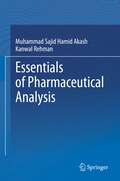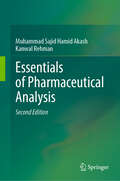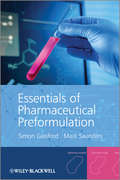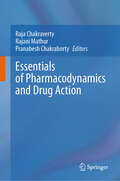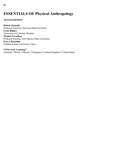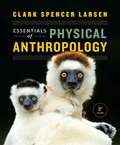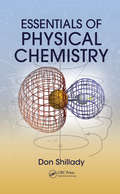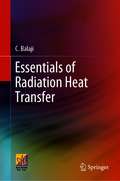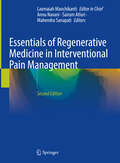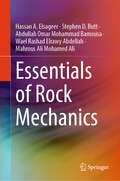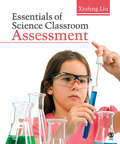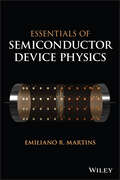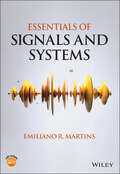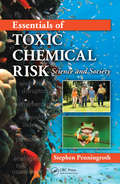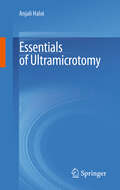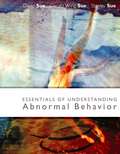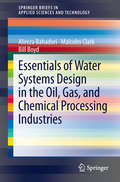- Table View
- List View
Essentials of Pharmaceutical Analysis
by Kanwal Rehman Muhammad Sajid AkashRecent advances in the pharmaceutical sciences and biotechnology have facilitated the production, design, formulation and use of various types of pharmaceuticals and biopharmaceuticals. This book provides detailed information on the background, basic principles, and components of techniques used for the analysis of pharmaceuticals and biopharmaceuticals. Focusing on those analytical techniques that are most frequently used for pharmaceuticals, it classifies them into three major sections and 19 chapters, each of which discusses a respective technique in detail. Chiefly intended for graduate students in the pharmaceutical sciences, the book will familiarize them with the components, working principles and practical applications of these indispensable analytical techniques.
Essentials of Pharmaceutical Analysis
by Kanwal Rehman Muhammad Sajid AkashThis 2nd edition of the comprehensive resource on pharmaceutical analysis and analytical techniques builds upon the success of its first edition by incorporating updated methodologies, expanded content, and fresh insights into modern practices. Designed for students, researchers, and industry professionals alike, the book bridges theoretical principles with practical applications, covering both classical methods and innovative approaches across spectrophotometry, chromatography, mass spectrometry, and thermal analysis. Detailed chapters elucidate method development, instrumentation, quality control, and regulatory compliance, while enriched case studies and examples from environmental science, biomedical research, and materials science illustrate real-world applications. New sections highlight the integration of miniaturized instruments, hyphenated techniques, and computational tools including machine learning and cloud-based analytics. Enhanced diagrams, tables, and summaries further facilitate the understanding of complex analytical concepts. This edition not only reinforces essential foundational knowledge but also equips readers with advanced practical skills to meet evolving challenges in pharmaceutical research and quality assurance. Whether you are seeking a solid academic grounding or aiming to adopt cutting-edge techniques, this book provides an indispensable guide to mastering contemporary pharmaceutical analysis and the future of analytical chemistry. With its rigorous and accessible approach, this book serves as an essential reference that inspires innovation in analytical sciences.
Essentials of Pharmaceutical Preformulation
by Simon Gaisford Mark SaundersEssentials of Pharmaceutical Preformulation is a study guide which describes the basic principles of pharmaceutical physicochemical characterisation. Successful preformulation requires knowledge of fundamental molecular concepts (solubility, ionisation, partitioning, hygroscopicity and stability) and macroscopic properties (physical form, such as the crystalline and amorphous states, hydrates, solvates and co-crystals and powder properties), familiarity with the techniques used to measure them and appreciation of their effect on product performance, recognising that often there is a position of compromise to be reached between product stability and bioavailability.This text introduces the basic concepts and discusses their wider implication for pharmaceutical development, with reference to many case examples of current drugs and drug products. Special attention is given to the principles and best-practice of the analytical techniques that underpin preformulation (UV spectrophotometry, TLC, DSC, XRPD and HPLC). The material is presented in the typical order that would be followed when developing a medicine and maps onto the indicative pharmacy syllabus of the Royal Pharmaceutical Society of Great BritainUndergraduate-level pharmacy students and R&D / analytical scientists working in the pharmaceutical sector (with or without a pharmaceutical background) will find this text easy to follow with relevant pharmaceutical examples.Essential study guide for pharmacy and pharmaceutical science studentsCovers the pharmaceutical preformulation components of the Royal Pharmaceutical Society of Great Britain's indicative syllabusEasy to follow text highlighted with relevant pharmaceutical examplesSelf-assessment assignments in a variety of formatsWritten by authors with both academic and industrial experienceCompanion website with further information to maximise learning
Essentials of Pharmacodynamics and Drug Action
by Raja Chakraverty Rajani Mathur Pranabesh ChakrabortyThe book provides a comprehensive exploration of the dynamic field of pharmacology and its fundamental principles. It delves into the intricate interactions between drugs and the human body, focusing on pharmacokinetics, which explains the dynamics of drug actions in the body, and pharmacodynamics, which uncovers the mechanisms through which drugs exert their effects. The book also emphasizes the crucial aspects of therapeutics and gene-based therapy, shedding light on modern approaches to disease treatment. Readers will gain insights into drugs that target the autonomic nervous system, influencing functions beyond voluntary control, and drugs that act on the central nervous system, impacting neurological processes. Additionally, the book examines medications affecting renal and cardiovascular functions, playing a significant role in maintaining homeostasis. Moreover, it explores the realm of drugs influencing gastrointestinal function, essential for digestive health.Furthermore, the book covers pharmacotherapy for microbial diseases, addressing the challenge of infectious agents and their treatment. It also investigates hormones and hormone antagonists, pivotal in regulating various physiological processes. Lastly, it provides a comprehensive understanding of drugs used for immunomodulation, which plays a crucial role in enhancing or suppressing the immune system.The book serves as a resource for students, researchers, and healthcare professionals seeking a deep understanding of drug interactions, therapeutic applications, and cutting-edge approaches in pharmacology.
Essentials of Photonics (Second Edition)
by Alan Rogers<p>The importance of photonics in science and engineering is widely recognized and will continue to increase through the foreseeable future. In particular, applications in telecommunications, medicine, astronomy, industrial sensing, optical computing and signal processing continue to become more diverse. <p>Essentials of Photonics, Second Edition describes the entire range of photonic principles and techniques in detail. Previously named Essentials of Optoelectronics, this newly named second edition of a bestseller felects changes that have occurred in this field. The book presents a new approach that concentrates on the physical principbestles, demonstrating their interdependence, and developing them to explain more complex phenomena. It gives insight into the underlying physical processes in a way that is readable and easy to follow, as well as entirely self-contained. <p>Written by an author with many years of experience in teaching and research, this book includes a detailed treatment of lasers, waveguides (including optical fibres), modulators, detectors, non-linear optics and optical signal processing. This new edition is brought up-to-date with additional sections on photonic crystal fibres, distributed optical-fibre sensing, and the latest developments in optical-fibre communications.</p>
Essentials of Physical Anthropology
by Robert Jurmain Lynn Kilgore Wenda Trevathan Eric BartelinkConcise, well-balanced, and comprehensive, ESSENTIALS OF PHYSICAL ANTHROPOLOGY, 10th Edition, introduces you to physical anthropology with the goal of helping you understand why it is important to know about human evolution. <p><p>You'll learn how humans are biologically connected to all other life, including our ancient ancestors and our contemporary primate cousins, and how closely modern human populations are related to each other. Numerous high-quality visual diagrams, artwork, maps, photographs, and other learning tools will help you grasp the big picture of human evolution.
Essentials of Physical Anthropology: Discovering Our Origins (Third Edition)
by Clark Spencer LarsenThe big picture of physical anthropology. Essentials of Physical Anthropology, Third Edition, is rich with stunning and photorealistic art, thoughtful pedagogy, innovative media, and up-to-date, student-centered content that illuminate physical anthropology’s most important themes.
Essentials of Physical Chemistry
by Don ShilladyAt a time when U.S. high school students are producing low scores in mathematics and science on international examinations, a thorough grounding in physical chemistry should not be considered optional for science undergraduates. Based on the author's thirty years of teaching, Essentials of Physical Chemistry merges coverage of calculus with chemist
Essentials of Polygraph and Polygraph Testing
by Nathan J. GordonThroughout history, there has been an intrinsic need for humans to detect deception in other humans. Developed in 1923, the polygraph machine was a tool designed to do just this. To date, there have been many improvements made to the basic polygraph instrument. This book outlines the instrumentation as well as the latest in questioning techniques and methods available to the professional interviewer to determine truth from deception. The book covers psychology and physiology, a history of polygraph with the advances of leading figures, question formulation, data analysis, legal implications and legal cases, and the author’s developed technique Integrated Zone Comparison Technique (IZCT).
Essentials of Radiation Heat Transfer (Ane/athena Bks.)
by C. BalajiEssentials of Radiation Heat Transfer focuses only on the essential topics required to gain an understanding of radiation heat transfer to enable the reader to master more challenging problems. The strength of the book lies in its elaborate presentation of the powerful radiosity-irradiation method and shows how this technique can be used to solve a variety of problems of radiation in enclosures made of one to any number of surfaces in both transparent and participating media. The book also introduces atmospheric radiation in which engineers can contribute to the technology of remote sensing and atmospheric sciences in general, by a better understanding of radiation.The author has included pedagogical features such as end-of-chapter exercises and worked examples with varying degrees of difficulty to augment learning and self-testing. The book has been written in an easy- to- follow conversational style to enhance reader engagement and learning outcomes. This book will be a useful guide for upper undergraduate and graduate students in the areas of mechanical engineering, aerospace engineering, atmospheric sciences, and energy sciences.
Essentials of Radiologic Science
by Denise OrthWhile maintaining the focused, student-friendly approach this title is known for, the updated 2nd Edition of Essentials of Radiologic Science now adds more detail and context on key topics to better meet the needs of today’s classroom. Designed throughout to help students succeed in the course and begin preparing for the ARRT examination from the very beginning of their program, the 2nd Edition now includes comprehensive coverage of digital imaging, an array of in-book and online learning tools to help students of all learning styles master the content, and a powerful suite of online instructor’s resources.
Essentials of Regenerative Medicine in Interventional Pain Management
by Laxmaiah ManchikantiRegenerative medicine is an emerging and integral part of interventional pain management and meets definitions of interventional pain management and interventional techniques. Interventional techniques are defined as minimally invasive procedures including, percutaneous precision needle placement, with placement of drugs in targeted areas or ablation of targeted nerves; and some surgical techniques such as laser or endoscopic diskectomy, intrathecal infusion pumps, and spinal cord stimulators, for the diagnosis and management of chronic, persistent, or intractable pain. On the same token, interventional pain management is defined as the discipline of medicine devoted to the diagnosis and treatment of pain related disorders principally with the application of interventional techniques in managing subacute, chronic, persistent, and intractable pain, independently or in conjunction with other modalities of treatment.This new edition brings a wide array of information for interventional pain physicians and other physicians practicing regenerative medicine with its applications in managing chronic pain and other disorders. The structure of the book begins with an introduction of the subject, followed by sections on historical context, pathophysiology, applicability of regenerative medicine with its evidence base, anatomy, technical aspects, complications, and precautions for each topic when available and applicable. From across the globe, leading experts in their respective fields contributed chapters on specific topics to present a cogent and integrative understanding of the field of regenerative medicine as applicable for interventional pain physicians. This comprehensive text achieves its goal of providing an evidence-based approach to application of principles of regenerative medicine in managing chronic pain of spinal, neurological, and musculoskeletal origins.
Essentials of Risk Theory
by Martin Peterson Sabine Roeser Per Sandin Rafaela HillerbrandRisk has become one of the main topics in fields as diverse as engineering, medicine and economics, and it is also studied by social scientists, psychologists and legal scholars. This Springer Essentials version offers an overview of the in-depth handbook and highlights some of the main points covered in the Handbook of Risk Theory. The topic of risk also leads to more fundamental questions such as: What is risk? What can decision theory contribute to the analysis of risk? What does the human perception of risk mean for society? How should we judge whether a risk is morally acceptable or not? Over the last couple of decades questions like these have attracted interest from philosophers and other scholars into risk theory. This brief offers the essentials of the handbook provides for an overview into key topics in a major new field of research and addresses a wide range of topics, ranging from decision theory, risk perception to ethics and social implications of risk. It aims to promote communication and information among all those who are interested in theoretical issues concerning risk and uncertainty. The Essentials of Risk Theory brings together internationally leading philosophers and scholars from other disciplines who work on risk theory. The contributions are accessibly written and highly relevant to issues that are studied by risk scholars. The Essentials of Risk Theory will be a helpful starting point for all risk scholars who are interested in broadening and deepening their current perspectives.
Essentials of Rock Mechanics
by Hassan A. Elsageer Stephen D. Butt Abdullah Omar Mohammad Bamousa Wael Rashad Abdellah Mahrous Ali AliThis book extensively covers rock mechanics and engineering, playing a vital role in mining, geological, and civil applications. It explores the stability, failure, and behavior of rock masses, offering control and prediction methods. Fundamental concepts, stress and strain analyses, failure theories, and rock characteristics are addressed, essential for safety in mining and construction. Applications like geological hazard assessment, slope stability, and foundation design demonstrate its significance in civil and geological engineering. The book's structured approach includes an overview in Chapter 1, stress analyses in Chapter 2, and plane strain analyses in Chapter 3. Subsequent chapters delve into rock behavior, failure theories, and specific properties. Practical aspects, such as designing underground openings, are covered in later chapters. The incorporation of numerous solved tutorials enhances its value for students and educators seeking a comprehensive understanding of these pivotal topics.
Essentials of Science Classroom Assessment
by Xiufeng LiuA concise science assessment text that helps K–12 teachers master the effective science assessment methods that lead to improved student learning Presenting both traditional and innovative assessment methods integral to science teaching and learning, Essentials of Science Classroom Assessment shows teachers the connection between effective science assessment and improved student learning. The text uses a competence-based approach consistent with the National Science Education Standards to help teachers master assessment skills, apply them to science classroom instruction, and evaluate their impact on student learning. Key Features and BenefitsProvides practical examples from both elementary and secondary science classrooms to demonstrate how to design a wide variety of traditional and innovative assessment methodsPresents case scenarios in each chapter that help teachers reflect on the assessment issues they will encounter in their own classrooms Includes end-of-chapter checklists and practice questions that allow readers to check their mastery of assessment skills before moving on, as well as annotated bibliographies that direct them to additional readings on topics of interest
Essentials of Semiconductor Device Physics
by Emiliano MartinsESSENTIALS OF SEMICONDUCTOR DEVICE PHYSICS An introductory semiconductor device physics textbook that is accessible to readers without a background in statistical physics The subject of this book is the physics of semiconductor devices, which is an important topic in engineering and physics because it forms the background for electronic and optoelectronic devices, including solar cells. The author aims to provide students and teachers with a concise text that focuses on semiconductor devices and covers the necessary background in statistical physics. This text introduces the key prerequisite knowledge in a simple, clear, and friendly manner. It distills the key concepts of semiconductor devices down to their essentials, enabling students to master this key subject in engineering, physics, and materials. The subject matter treated in this book is directly connected to the physics of p-n junctions and solar cells, which has become a topic of intense interest in the last decade. Sample topics covered within the text include: Chemical potential, Fermi level, Fermi-Dirac distribution, drift current and diffusion current. The physics of semiconductors, band theory and intuitive derivations of the concentration of charge carriers. The p-n junction, with qualitative analysis preceding the mathematical descriptions. A derivation of the current vs voltage relation in p-n junctions (Shockley equation). Important applications of p-n junctions, including solar cells The two main types of transistors: Bipolar Junction Transistors (BJT) and Metal Oxide Semiconductor Field Effect Transistors (MOSFET) For students and instructors, it may be used as a primary textbook for an introductory semiconductor device physics course and is suitable for a course of approximately 30-50 hours. Scientists studying and researching semiconductor devices in general, and solar cells in particular, will also benefit from the clear and intuitive explanations found in this book.
Essentials of Signals and Systems
by Emiliano R. MartinsNovel approach to the theory of signals and systems in an introductory, accessible textbook Signals and Systems have the reputation of being a difficult subject. Essentials of Signals and Systems is a standalone textbook aiming to change this reputation with a novel approach to this subject, teaching the essential concepts of signals and systems in a clear, friendly, intuitive, and accessible way. The overall vision of the book is that traditional approaches to signals and systems are unnecessarily convoluted, and that students’ learning experiences are much improved by making a clear connection between the theory of representation of signal and systems, and the theory of representation of vectors and matrices in linear algebra. The author begins by reviewing the theory of representation in linear algebra, emphasizing that vectors are represented by different coordinates when the basis is changed, and that the basis of eigenvectors is special because it diagonalizes the operator. Thus, in each step of the theory of representation of signals and systems, the author shows the analogous step in linear algebra. With such an approach, students can easily understand that signals are analogous to vectors, that systems are analogous to matrices, and that Fourier transforms are a change to the basis that diagonalizes LTI operators. The text emphasizes the key concepts in the analysis of linear and time invariant systems, demonstrating both the algebraic and physical meaning of Fourier transforms. The text carefully connects the most important transforms (Fourier series, Discrete Time Fourier Transform, Discrete Fourier Transforms, Laplace and z-transforms), emphasizing their relationships and motivations. The continuous and discrete time domains are neatly connected, and the students are shown step-by-step how to use the fft function, using simple examples. Incorporating learning objectives and problems, and supported with simple Matlab codes to illustrate concepts, the text presents to students the foundations to allow the reader to pursue more advanced topics in later courses. Developed from lecture notes already tested with more than 600 students over six years, Essentials of Signals and Systems covers sample topics such as: Basic concepts of linear algebra that are pertinent to signals and systems. Theory of representation of signals, with an emphasis on the notion of Fourier transforms as a change of basis, and on their physical meaning. Theory of representation of linear and time invariant systems, emphasizing the role of Fourier transforms as a change to the basis of eigenvectors, and the physical meaning of the impulse and frequency responses. What signals and systems have to do with phasors and impedances, and the basics of filter design. The Laplace transform as an extension of Fourier transforms. Discrete signals and systems, the sampling theorem, the Discrete Time Fourier Transform (DTFT), the Discrete Fourier Transform (DFT), and how to use the fast fourier transform (fft). The z-transform as an extension of the Discrete Time Fourier Transform. Essentials of Signals and Systems is an immensely helpful textbook on the subject for undergraduate students of electrical and computer engineering. The information contained within is also pertinent to those in physics and related fields involved in the understanding of signals and system processing, including those working on related practical applications.
Essentials of Single-Cell Analysis
by Fan-Gang Tseng Tuhin Subhra SantraThis book provides an overview of single-cellisolation, separation, injection,lysis and dynamics analysis as well as a study of their heterogeneity usingdifferent miniaturized devices. As an important part of single-cell analysis, differenttechniques including electroporation,microinjection, optical trapping, optoporation, rapid electrokinetic patterningand optoelectronictweezers are described in detail. It presents different fluidicsystems (e. g. continuous micro/nano-fluidic devices, microfluidic cytometry)and their integration with sensor technology, optical and hydrodynamic stretchers etc. ,and demonstrates the applications of single-cell analysis in systems biology,proteomics, genomics, epigenomics, cancer transcriptomics, metabolomics,biomedicine and drug delivery systems. It also discusses the future challengesfor single-cell analysis, including the advantages and limitations. This book is enjoyable reading material whileat the same time providing essential information to scientists in academia andprofessionals in industry working on different aspects of single-cellanalysis. Dr. Fan-Gang Tseng is a Distinguished Professor ofEngineering and System Science atthe National Tsing Hua University, Taiwan. Dr. Tuhin Subhra Santra is a Research Associate at the California Nano Systems Institute, University of California at Los Angeles, USA.
Essentials of Soft Matter Science
by Francoise Brochard-Wyart Pierre Nassoy Pierre-Henri PuechAuthored by world-leading physicists, this introductory textbook explores the basic principles of polymers, colloids, liquid crystals, wetting, and foams. It is a practical ‘toolbox’ for readers to acquire basic knowledge in the field and facilitate further reading and advanced courses. Undergraduate students in physics, biology, and the medical sciences will learn the basics of soft matter physics, in addition to scaling approaches in the spirit of the Nobel prize laureate in physics in 1991, Pierre-Gilles de Gennes, the inventor of soft matter physics and close collaborator to author Françoise Brochard-Wyart. Features: Accessible and compact approach Contains exercises to enhance understanding All chapters are followed by a short 1-2 page "insert chapter" which serve as illustrations with concrete examples from everyday life (e.g. the Paris Metro, a zebrafish, a gecko, duck feathers etc.)
Essentials of Tissue and Cells Banking
by George Galea Marc Turner Sharon ZahraIt has been 10 years since the first edition of ‘Essentials of Tissue Banking’ has been published. There is still relatively little published on the technical and scientific principles on routine tissue and cell banking based on scientific principles. The 1st edition was very successful and, after a 10 year gap, there is a need of an update and an expansion of the book’s remit.The format of the book follows that of the previous edition- split into 5 sections. Management of donors and the banking of common tissues and cells; Principles of storage and processing of tissues and cells; Ensuring the safety of the products by testing the donor, the tissues and the environment, supported by a quality system and an IT infrastructure- all working within the constraints of current regulatory and ethical environments.This edition however provides a significant update. Many the chapters have been completely rewritten by different experts. Like the 1st edition, they were given a free hand in the way they wrote their chapter, with a guideline that they had to be concise, clear and up to date. The authors were also asked to provide the scientific and technical basis that provides the rationale of the processes they describe. Also, the scope of the book has been somewhat extended. In view of the fact that many cellular therapies are now routinely practiced, 2 new chapters have been added: one on the banking of haematopoietic stem cells and one on human embryonic stem cells. They have been deliberately chosen to illustrate the extreme spectrum of cellular therapies from one of the simplest to one of the most complex. The intention of the book has remained the same: to cover and update banking of current practices in essential tissue and cell banking. It is therefore hoped that by keeping the book as concise and up to date as possible, it will find a place on the shelves of many tissue establishments.
Essentials of Toxic Chemical Risk: Science and Society
by Stephen PenningrothThis volume provides a basic introduction to toxicology within a framework of chemical risk to ecosystems and to human health and forms the basis of a new approach to teaching toxicology from a broad, interdisciplinary perspective. It presents concepts from chemistry, ecology, physiology, and other disciplines as needed within the context of toxicology. These include chemical equilibrium, energy, and nutrient flows through ecosystems. It also introduces concepts specific to toxicology, such as risk as a composite of toxicity and exposure, and provides case studies of risk management to illustrate the ways in which laboratory results are used to manage chemical risk to human health and the environment.
Essentials of Ultramicrotomy
by Anjali HaloiThis book commences with an introduction to the fundamental principles of light and electron microscopy, laying the groundwork for readers to grasp the significance of ultramicrotomy within these fields. It addresses every aspect of ultramicrotomy, including its history, instrumentation, procedural intricacies, as well as guidelines for maintenance and troubleshooting. A number of images and illustrations have been included to depict every step of the ultramicrotomy procedure to facilitate deeper understanding of the subject. It also talks about different techniques that can be employed for enhancing the quality and precision of the microscopy results. This book is a resource for researchers, faculty members, students, microtomists and microscopists working on sample preparation and analysis through transmission electron microscopy.
Essentials of Understanding Abnormal Behavior
by David Sue Herald Wing Sue Stanley SueAn elaborate text on why people exhibit abnormal behaviours, how they express their disturbances, and how such behaviours can be prevented, diagnosed and treated.
Essentials of Water Systems Design in the Oil, Gas, and Chemical Processing Industries
by Malcolm Clark Bill Boyd Alireza BahadoriEssentials of Water Systems Design in the Oil, Gas and Chemical Processing Industries provides valuable insight for decision makers by outlining key technical considerations and requirements of four critical systems in industrial processing plants--water treatment systems, raw water and plant water systems, cooling water distribution and return systems, and fire water distribution and storage facilities. The authors identify the key technical issues and minimum requirements related to the process design and selection of various water supply systems used in the oil, gas, and chemical processing industries. This book is an ideal, multidisciplinary work for mechanical engineers, environmental scientists, and oil and gas process engineers.
Essentials of the Living World
by George Johnson Joel BerghJohnson’s Essentials of The Living World text is written with an emphasis on the "how” and “why” of Biology, focusing on concepts rather than terminology and technical information. Utilizing a clear, straightforward writing style, the text helps students apply scientific principles to daily life. The 7th edition includes contributions and pedagogy from new coauthor, Dr. Joel Bergh.
